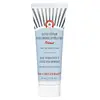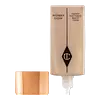What's inside
What's inside
 Key Ingredients
Key Ingredients

 Benefits
Benefits

 Concerns
Concerns

 Ingredients Side-by-side
Ingredients Side-by-side

Water
Skin ConditioningCyclopentasiloxane
EmollientCoco-Caprylate/Caprate
EmollientDimethicone/Vinyl Dimethicone Crosspolymer
Skin ConditioningC12-15 Alkyl Benzoate
AntimicrobialButylene Glycol
HumectantGlycerin
HumectantLauroyl Lysine
Skin ConditioningSodium Acrylate/Sodium Acryloyldimethyl Taurate Copolymer
Emulsion StabilisingDimethicone Crosspolymer
Emulsion StabilisingCaprylic/Capric Triglyceride
MaskingMica
Cosmetic ColorantPhenoxyethanol
PreservativeIsohexadecane
EmollientCI 77891
Cosmetic ColorantPolysorbate 80
EmulsifyingC12-14 Pareth-12
EmulsifyingEthylhexylglycerin
Skin ConditioningAloe Barbadensis Leaf Juice
Skin ConditioningDisodium EDTA
Santalum Album Wood Extract
PerfumingCamellia Sinensis Leaf Extract
AntimicrobialChrysanthemum Parthenium Extract
Skin ConditioningGlycyrrhiza Glabra Root Extract
BleachingChlorphenesin
AntimicrobialSodium Hyaluronate
HumectantTin Oxide
AbrasiveCucumis Melo Fruit Extract
Skin ConditioningCucumis Sativus Fruit Extract
EmollientPrunus Armeniaca Fruit Extract
Skin ConditioningPyrus Malus Fruit Extract
Skin ConditioningRose Extract
Skin ConditioningRubus Idaeus Fruit Extract
AstringentTocopherol
AntioxidantPotassium Sorbate
PreservativeSodium Benzoate
MaskingCitric Acid
BufferingSodium Hydroxide
BufferingWater, Cyclopentasiloxane, Coco-Caprylate/Caprate, Dimethicone/Vinyl Dimethicone Crosspolymer, C12-15 Alkyl Benzoate, Butylene Glycol, Glycerin, Lauroyl Lysine, Sodium Acrylate/Sodium Acryloyldimethyl Taurate Copolymer, Dimethicone Crosspolymer, Caprylic/Capric Triglyceride, Mica, Phenoxyethanol, Isohexadecane, CI 77891, Polysorbate 80, C12-14 Pareth-12, Ethylhexylglycerin, Aloe Barbadensis Leaf Juice, Disodium EDTA, Santalum Album Wood Extract, Camellia Sinensis Leaf Extract, Chrysanthemum Parthenium Extract, Glycyrrhiza Glabra Root Extract, Chlorphenesin, Sodium Hyaluronate, Tin Oxide, Cucumis Melo Fruit Extract, Cucumis Sativus Fruit Extract, Prunus Armeniaca Fruit Extract, Pyrus Malus Fruit Extract, Rose Extract, Rubus Idaeus Fruit Extract, Tocopherol, Potassium Sorbate, Sodium Benzoate, Citric Acid, Sodium Hydroxide
Water
Skin ConditioningDimethicone
EmollientCyclopentasiloxane
EmollientPolysilicone-11
Butylene Glycol
HumectantGlycerin
HumectantSilica
AbrasiveMica
Cosmetic ColorantSqualane
EmollientCI 77891
Cosmetic ColorantNylon-12
Isononyl Isononanoate
EmollientPhenoxyethanol
PreservativeHydroxyethyl Acrylate/Sodium Acryloyldimethyl Taurate Copolymer
Emulsion StabilisingSodium Potassium Aluminum Silicate
Avena Sativa Kernel Extract
AbrasiveEthylhexylglycerin
Skin ConditioningIsohexadecane
EmollientPEG-10 Dimethicone
Skin ConditioningTocopheryl Acetate
AntioxidantCarbomer
Emulsion StabilisingPolysorbate 60
EmulsifyingPolysorbate 40
EmulsifyingHydrolyzed Viola Tricolor Extract
Skin ProtectingCaramel
Cosmetic ColorantAllantoin
Skin ConditioningAloe Barbadensis Leaf Juice
Skin ConditioningDisodium EDTA
Camellia Oleifera Seed Oil
Skin ConditioningRosa Canina Fruit Oil
EmollientAmmonium Polyacryloyldimethyl Taurate
Emulsion StabilisingNylon-12 Fluorescent Brightener 230 Salt
Sodium Hydroxide
BufferingCI 77491
Cosmetic ColorantSodium Hyaluronate
HumectantSodium Lactate
BufferingSorbitan Isostearate
EmulsifyingCoco-Glucoside
CleansingCI 77492
Cosmetic ColorantParfum
MaskingCI 77499
Cosmetic ColorantPolyvinylalcohol Crosspolymer
Helianthus Annuus Seed Oil
EmollientPalmitoyl Tetrapeptide-7
Skin ConditioningPalmitoyl Tripeptide-1
Skin ConditioningTin Oxide
AbrasiveNicotiana Sylvestris Leaf Cell Culture
Skin ConditioningRosa Damascena Flower Oil
MaskingTocopherol
AntioxidantPlumeria Rubra Flower Extract
Skin ConditioningAnthemis Nobilis Flower Oil
MaskingCitronellol
PerfumingGeraniol
PerfumingWater, Dimethicone, Cyclopentasiloxane, Polysilicone-11, Butylene Glycol, Glycerin, Silica, Mica, Squalane, CI 77891, Nylon-12, Isononyl Isononanoate, Phenoxyethanol, Hydroxyethyl Acrylate/Sodium Acryloyldimethyl Taurate Copolymer, Sodium Potassium Aluminum Silicate, Avena Sativa Kernel Extract, Ethylhexylglycerin, Isohexadecane, PEG-10 Dimethicone, Tocopheryl Acetate, Carbomer, Polysorbate 60, Polysorbate 40, Hydrolyzed Viola Tricolor Extract, Caramel, Allantoin, Aloe Barbadensis Leaf Juice, Disodium EDTA, Camellia Oleifera Seed Oil, Rosa Canina Fruit Oil, Ammonium Polyacryloyldimethyl Taurate, Nylon-12 Fluorescent Brightener 230 Salt, Sodium Hydroxide, CI 77491, Sodium Hyaluronate, Sodium Lactate, Sorbitan Isostearate, Coco-Glucoside, CI 77492, Parfum, CI 77499, Polyvinylalcohol Crosspolymer, Helianthus Annuus Seed Oil, Palmitoyl Tetrapeptide-7, Palmitoyl Tripeptide-1, Tin Oxide, Nicotiana Sylvestris Leaf Cell Culture, Rosa Damascena Flower Oil, Tocopherol, Plumeria Rubra Flower Extract, Anthemis Nobilis Flower Oil, Citronellol, Geraniol
Ingredients Explained
These ingredients are found in both products.
Ingredients higher up in an ingredient list are typically present in a larger amount.
Aloe Barbadensis Leaf Juice comes from leaves of the aloe plant. Aloe Barbadensis Leaf Juice is best known for helping to soothe sunburns. It is also anti-inflammatory, moisturizing, antiseptic, and can help heal wounds.
Aloe is packed with good stuff including Vitamins A, C, and E. These vitamins are antioxidants, which help fight free-radicals and the damage they may cause. Free-radicals are molecules that may damage your skin cells, such as pollution.
Aloe Barbadensis Leaf Juice also contains sugars. These sugars come in the form of monosaccharides and polysaccharides, folic acid, and choline. These sugars are able to help bind moisture to skin.
It also contains minerals such as calcium, 12 anthraquinones, fatty acids, amino acids, and Vitamin B12.
Learn more about Aloe Barbadensis Leaf JuiceButylene Glycol (or BG) is used within cosmetic products for a few different reasons:
Overall, Butylene Glycol is a safe and well-rounded ingredient that works well with other ingredients.
Though this ingredient works well with most skin types, some people with sensitive skin may experience a reaction such as allergic rashes, closed comedones, or itchiness.
Learn more about Butylene GlycolCi 77891 is a white pigment from Titanium dioxide. It is naturally found in minerals such as rutile and ilmenite.
It's main function is to add a white color to cosmetics. It can also be mixed with other colors to create different shades.
Ci 77891 is commonly found in sunscreens due to its ability to block UV rays.
Learn more about CI 77891Cyclopentasiloxane, or D5, is a silicone used to improve texture of products and trap moisture.
D5 is considered lightweight and volatile. Volatile means it evaporates quickly after application. Once evaporated, D5 leaves a thin barrier that helps keep skin hydrated.
It is also an emollient. Emollients help soften the skin and prevent water loss. Silicones create a silky texture in products. D5 helps other ingredients become more spreadable.
Studies show D5 is safe to use in skincare products. We recommend speaking with a skincare professional if you have concerns.
Learn more about CyclopentasiloxaneDisodium EDTA plays a role in making products more stable by aiding other preservatives.
It is a chelating agent, meaning it neutralizes metal ions that may be found in a product.
Disodium EDTA is a salt of edetic acid and is found to be safe in cosmetic ingredients.
Learn more about Disodium EDTAEthylhexylglycerin (we can't pronounce this either) is commonly used as a preservative and skin softener. It is derived from glyceryl.
You might see Ethylhexylglycerin often paired with other preservatives such as phenoxyethanol. Ethylhexylglycerin has been found to increase the effectiveness of these other preservatives.
Glycerin is already naturally found in your skin. It helps moisturize and protect your skin.
A study from 2016 found glycerin to be more effective as a humectant than AHAs and hyaluronic acid.
As a humectant, it helps the skin stay hydrated by pulling moisture to your skin. The low molecular weight of glycerin allows it to pull moisture into the deeper layers of your skin.
Hydrated skin improves your skin barrier; Your skin barrier helps protect against irritants and bacteria.
Glycerin has also been found to have antimicrobial and antiviral properties. Due to these properties, glycerin is often used in wound and burn treatments.
In cosmetics, glycerin is usually derived from plants such as soybean or palm. However, it can also be sourced from animals, such as tallow or animal fat.
This ingredient is organic, colorless, odorless, and non-toxic.
Glycerin is the name for this ingredient in American English. British English uses Glycerol/Glycerine.
Learn more about GlycerinIsohexadecane is added to enhance texture, emulsify, and to help cleanse. It is an isoparrafin. It is a component of petrolatum.
Due to its large size, Isohexadecane is not absorbed by the skin. Instead, it sits on top and acts as an emollient. Emollients help keep your skin soft and smooth by trapping moisture within.
Isohexadecane is often used in products designed to help oily skin. It is lightweight and non-greasy while helping to moisturize. When mixed with silicones, it gives a product a silky feel.
Learn more about IsohexadecaneMica is a naturally occurring mineral used to add shimmer and color in cosmetics. It can also help improve the texture of a product or give it an opaque, white/silver color.
Serecite is the name for very fine but ragged grains of mica.
This ingredient is often coated with metal oxides like titanium dioxide. Trace amounts of heavy metals may be found in mica, but these metals are not harmful in our personal products.
Mica has been used since prehistoric times throughout the world. Ancient Egyptian, Indian, Greek, Roman, Aztec, and Chinese civilizations have used mica.
Learn more about MicaPhenoxyethanol is a preservative that has germicide, antimicrobial, and aromatic properties. Studies show that phenoxyethanol can prevent microbial growth. By itself, it has a scent that is similar to that of a rose.
It's often used in formulations along with Caprylyl Glycol to preserve the shelf life of products.
Sodium Hyaluronate is hyaluronic acid's salt form. It is commonly derived from the sodium salt of hyaluronic acid.
Like hyaluronic acid, it is great at holding water and acts as a humectant. This makes it a great skin hydrating ingredient.
Sodium Hyaluronate is naturally occurring in our bodies and is mostly found in eye fluid and joints.
These are some other common types of Hyaluronic Acid:
Learn more about Sodium HyaluronateSodium Hydroxide is also known as lye or caustic soda. It is used to adjust the pH of products; many ingredients require a specific pH to be effective.
In small amounts, sodium hydroxide is considered safe to use. However, large amounts may cause chemical burns due to its high alkaline.
Your skin has a natural pH and acid mantle. This acid mantle helps prevent harmful bacteria from breaking through. The acid mantle also helps keep your skin hydrated.
"Alkaline" refers to a high pH level. A low pH level would be considered acidic.
Learn more about Sodium HydroxideTin Oxide is an inorganic oxide used to add opacity and volume to a product. In nature, it is already found in mineral form. The main ore of tin is an opaque and shiny mineral called casseterite.
Tin Oxide helps remove translucency in a product, or make it more opaque. Besides adding opacity, tin oxide is used for bulking to add volume.
Tocopherol (also known as Vitamin E) is a common antioxidant used to help protect the skin from free-radicals and strengthen the skin barrier. It's also fat soluble - this means our skin is great at absorbing it.
Vitamin E also helps keep your natural skin lipids healthy. Your lipid skin barrier naturally consists of lipids, ceramides, and fatty acids. Vitamin E offers extra protection for your skin’s lipid barrier, keeping your skin healthy and nourished.
Another benefit is a bit of UV protection. Vitamin E helps reduce the damage caused by UVB rays. (It should not replace your sunscreen). Combining it with Vitamin C can decrease sunburned cells and hyperpigmentation after UV exposure.
You might have noticed Vitamin E + C often paired together. This is because it is great at stabilizing Vitamin C. Using the two together helps increase the effectiveness of both ingredients.
There are often claims that Vitamin E can reduce/prevent scarring, but these claims haven't been confirmed by scientific research.
Learn more about TocopherolWater. It's the most common cosmetic ingredient of all. You'll usually see it at the top of ingredient lists, meaning that it makes up the largest part of the product.
So why is it so popular? Water most often acts as a solvent - this means that it helps dissolve other ingredients into the formulation.
You'll also recognize water as that liquid we all need to stay alive. If you see this, drink a glass of water. Stay hydrated!
Learn more about Water